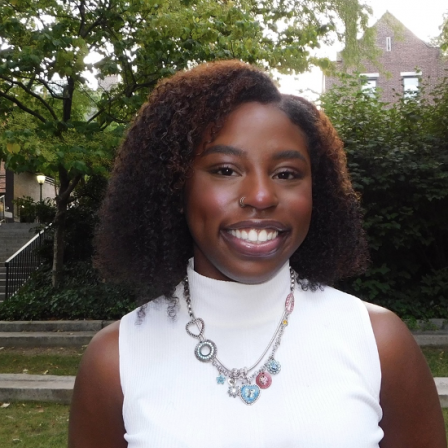

Tanner House Reseach Assistant

Leaving West Philly to attend Mother Tuskegee was a journey guided by faith rather than sight. I embarked on this path without having all the answers as to why Alabama called to me—a sentiment that I believe resonates with the spirit of Halle Tanner Dillion Johnson. My time at Tuskegee became an iterative process of self-discovery, delving into the rich history of Black artists, architects, and academics. It was here that I uncovered my passion for Historic Preservation.
Tuskegee introduced me to the realms of art conservation and historic preservation, and under the guidance of Dr. Jontyle Robinson and Dr. Kwesi Daniels, I found mentors who welcomed me into their professions and granted me access to their invaluable pedagogy. Through my participation in The Alliance Programs with Dr. Robinson, I collaborated with fellow HBCU students, learning from top institutions and industry leaders within the museum realm. The Alliance programming at Tuskegee served as a gateway, enabling me to transfer my knowledge of art and Black culture into the field of preservation, operating within a social justice framework as a conservator (it was also where I learned of Henry Ossawa Tanner). Pivoting into the historic preservation field was easier as it now incorporates treatment techniques from the art conservation world. Working alongside Dr. Daniels, I embraced the notion that every limitation presented itself as a powerful challenge, fostering my ability to uplift Black life through my work.
Transitioning from an HBCU to an Ivy League School, home to one of the oldest historic preservation programs in the country, presented its social challenges. However, recognizing the historic significance of my journey was crucial. The conservation science field remains less than one percent Black, making my presence historically significant. As I approach the culmination of my graduate studies at Penn, I eagerly sought avenues to work alongside community members and I was introduced to the faculty of CPCRS and FOTH organization. Joining the team at the Tanner House fills me with excitement, as I get to collaborate with individuals who value the new framework of preservation and social justice, aiming to preserve history for its current community. My mission is to bring conservation science tools to the site and continue introducing Black individuals to this work. Through this, we can celebrate our Black Cultural founders, creators, creatives, and activists of change, such as Henry Ossawa Tanner, leveraging his story and space for educational and healing purposes in the North Philadelphia community.
Beyond my work at the Tanner House this year, my journey continues with a focus on climate change and its impact on historic properties. I am exploring the creation of policies to preserve our cultural sites and landscapes in the aftermath of wildfires. My thesis involves drafting a pilot policy addressing social issues and scientific mitigation efforts. Collaborating with my Tuskegee professor and friend, Amma Asomah, on a grant project to identify Black women artists and storytellers further contributes to my multifaceted approach. Meanwhile, as a board member of the Black Women Graduate Association (BGWA), I hold space for Black women graduate students. Grateful for my time at Mother Tuskegee and the guidance of my mentors along this journey, I am enthusiastic about the diverse challenges and opportunities that lie ahead.